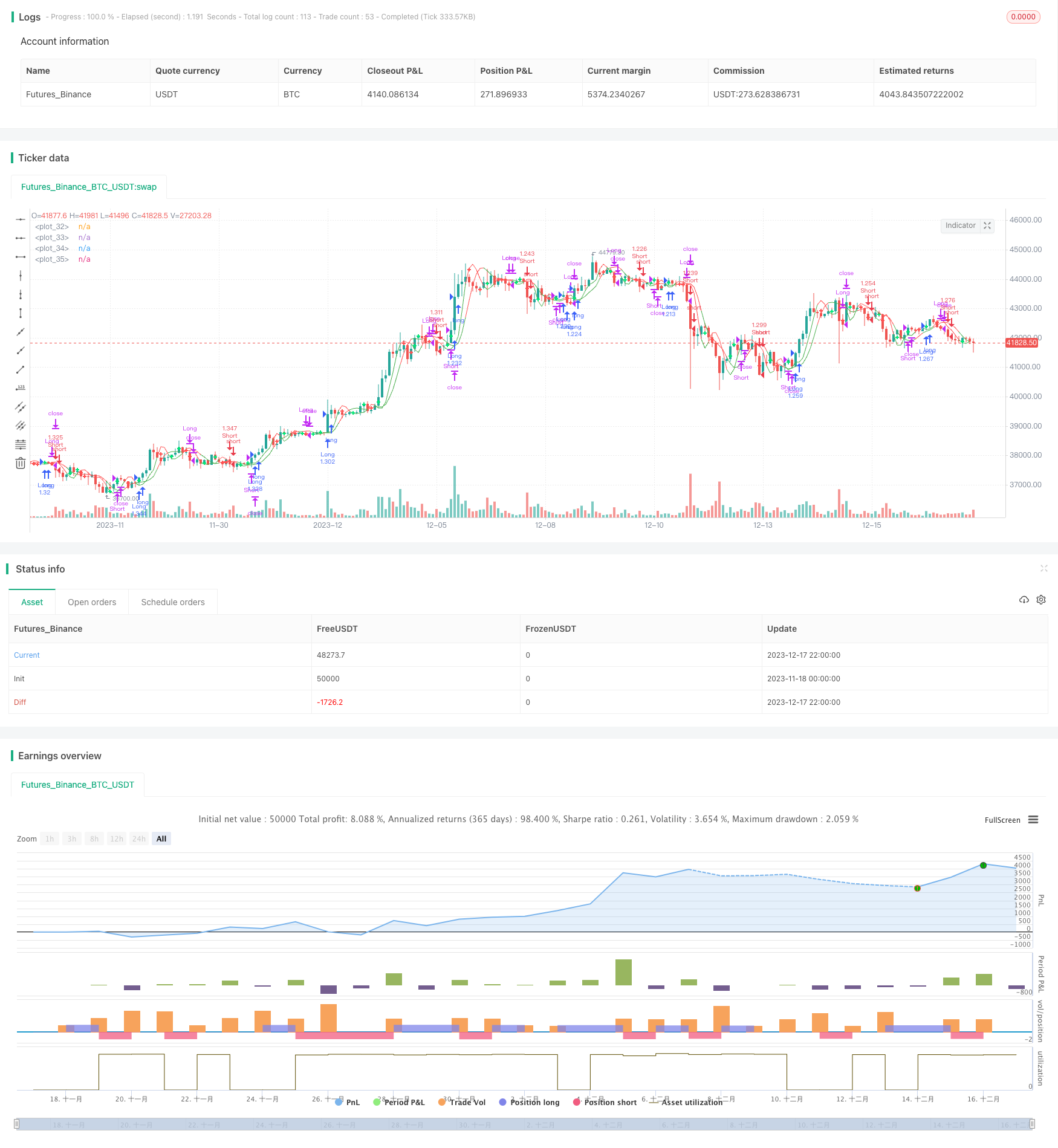
概述
本策略通过组合使用双重Hull移动平均线指标、容量加权移动平均线指标、MACD指标和真实力度指数指标,实现对趋势的精确判断。它能够自动适应市场环境的变化,具有较强的适应性。
策略原理
该策略的核心指标是双重Hull移动平均线,它由两个参数keh和teh控制计算。这两个参数分别确定了快线和慢线的周期。快线和慢线构成金叉死叉,判断目前趋势。
辅助判断指标有容量加权移动平均线meh1。当价格高于meh1时,为看涨形势;价格低于meh1时,为看跌形势。
另一个辅助判断指标是MACD。它由快速移动平均线减去慢速移动平均线得到MACD,再用MACD的移动平均线得到讯号线。当MACD高于讯号线时为看涨形势。
最后一个辅助判断指标是TSI,它通过价格变化率的双重平滑计算得到。其绝对值大小代表价格变化的势头。在买入和卖出条件中,对TSI的讯号线进行判断,控制Entries和Exits的时机。
综合这几个指标的信号,可以准确判断趋势,并且自动调整参数,与市场达到同步。
策略优势
使用双重Hull移动平均线作为主要判断指标,辅以其他多个指标组合使用,可以提高判断准确性,降低假信号。
应用TSI指标判断入市和出市的时机,可以控制风险。
多种参数可以自行调整,适应性强,可以自动适应市场变化。
采用指标组合和参数自适应的思路,使策略稳定性好,连续盈利能力强。
风险分析
虽然加入了TSI指标判断时机,但gorithm使用的指标还是趋势类型,如果遇到震荡抽头市场,会增大盈亏波动。
参数设置不当可能导致策略失效,需要根据自己的经验合理设定参数。
多指标组合增加了计算量,在数据量大的股票和时间段上报错的可能性会增大,需要控制数据范围。
需要监控指标的计算效果,防止异常数据的干扰。
策略优化方向
可以测试添加其他辅助指标,如BOLL指标等,使信号更加准确可靠。
优化入市出市逻辑,设置止损止盈条件,控制单笔盈亏。
对交易品种参数进行训练和优化,使其更好地适应不同品种。
增加参数自适应模块,使策略参数可以根据最近交易效果自动调整。
总结
本策略集成了多种指标的优势,采用指标组合判断趋势方向,在控制风险的同时,提高了判断的准确性。通过参数优化和逻辑优化,可以使策略更好地适应市场变化,在降低连续亏损的基础上获取更大利润。本策略稳定性好,可以长期应用在股票和加密货币等品种上。
/*backtest
start: 2023-11-18 00:00:00
end: 2023-12-18 00:00:00
period: 2h
basePeriod: 15m
exchanges: [{"eid":"Futures_Binance","currency":"BTC_USDT"}]
*/
//@version=2
// Quad-HullMA-cross & VWMA & MacD & TSI combination <<<<< by SeaSide420 >>>>>>
strategy("MultiCross420", overlay=true, calc_on_order_fills= true, calc_on_every_tick=true, default_qty_type=strategy.percent_of_equity, default_qty_value=100, pyramiding=0)
keh=input(title="Double HullMA 1",defval=7, minval=1)
teh=input(title="Double HullMA 2",defval=14, minval=1)
meh=input(title="VWMA",defval=1, minval=1)
meh1=vwma(close,round(meh))
n2ma=2*wma(close,round(keh/2))
nma=wma(close,keh)
diff=n2ma-nma,sqn=round(sqrt(keh))
n2ma1=2*wma(close[2],round(keh/2))
nma1=wma(close[2],keh)
diff1=n2ma1-nma1,sqn1=round(sqrt(keh))
n1=wma(diff,sqn)
n2=wma(diff1,sqn)
b=n1>n2?lime:red
c=n1>n2?green:red
n2ma3=2*wma(close,round(teh/2))
nma2=wma(close,teh)
diff2=n2ma3-nma2,sqn2=round(sqrt(teh))
n2ma4=2*wma(close[2],round(teh/2))
nma3=wma(close[2],teh)
diff3=n2ma4-nma3,sqn3=round(sqrt(teh))
n3=wma(diff2,sqn2)
n4=wma(diff3,sqn3)
fastLength = input(title="MacD fastLength", defval=7)
slowlength = input(title="MacD slowlength", defval=14)
MACDLength = input(title="MacD Length", defval=3)
MACD = ema(close, fastLength) - ema(close, slowlength)
aMACD = ema(MACD, MACDLength)
delta = MACD - aMACD
a1=plot(n1,color=c),a2=plot(n2,color=c)
plot(cross(n1, n2) ? n1 : na, style = cross, color=b, linewidth = 3)
a3=plot(n3,color=c),a4=plot(n4,color=c)
plot(cross(n3, n4) ? n1 : na, style = cross, color=b, linewidth = 3)
//a5=plot(meh1,color=c)
long = input(title="TSI Long Length", defval=5)
short = input(title="TSI Short Length", defval=3)
signal = input(title="TSI Signal Length", defval=2)
linebuy = input(title="TSI Upper Line", defval=4)
linesell = input(title="TSI Lower Line", defval=-4)
price = close
double_smooth(src, long, short) =>
fist_smooth = ema(src, long)
ema(fist_smooth, short)
pc = change(price)
double_smoothed_pc = double_smooth(pc, long, short)
double_smoothed_abs_pc = double_smooth(abs(pc), long, short)
tsi_value = 100 * (double_smoothed_pc / double_smoothed_abs_pc)
closelong = n1<n2 and n3<n4 and n1>meh1
if (closelong)
strategy.close("Long")
closeshort = n1>n2 and n3>n4 and n1<meh1
if (closeshort)
strategy.close("Short")
longCondition = strategy.opentrades<1 and n1>n2 and MACD>aMACD and n1<meh1 and n3>n4 and ema(tsi_value, signal)>linesell
if (longCondition)
strategy.entry("Long",strategy.long)
shortCondition = strategy.opentrades<1 and n1<n2 and MACD<aMACD and n1>meh1 and n3<n4 and ema(tsi_value, signal)<linebuy
if (shortCondition)
strategy.entry("Short",strategy.short)